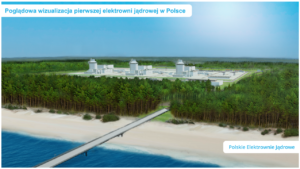Serhiy Oleksiyenko, acting president of Ukrtransgaz says that Ukraine could import up to 5 bcm of gas a year, but the obstacle are infrastructural limitations on the Polish territory.
BiznesAlert.pl: What is the current stage of Polish-Ukrainian gas cooperation?
Oleksiyenko: We are speaking with Gaz-System on increasing gas supplies from Poland.
Did LNG from Poland come to Ukraine already?
One can assume that at least few molecules of Polish LNG were delivered to Ukraine eventually because it is mixed with natural gas in Polish system and gets to Ukraine. I do not know anything about dedicated packages but a portion of PGNiG portfolio is liquified gas and it is a major supplier to Ukraine from Poland. I am sure they are already planning increasing gas export to Ukraine and import of LNG in one exercise.
What is the stage of talks on LNG supplies to Ukraine?
Naftogaz requested to contract some volumes of LNG delivered to Świnoujście, to borrow PGNiG capacity and such dedicated volumes would be supplied to Ukraine. This is the project to be discussed with Gaz-System on technical measures to make this happen.
Are there any challenges?
Continued blocking of existing capacity with Poland by Gazprom. Drozdowicze point is able to pass 15 mcm a day for export and import, Hermanowicze import to Ukraine is roughly 7 mcm in summer, less than 5 mcm in winter. Operators agreement between Gaz-System and Ukrtransgaz will let us use those points according to market rules. We discussed this with Gaz-System in the beginning of June in Ukraine. I hope that we will have an agreement at the end of June.
What would be the reaction of Gazprom?
It is not difficult to predict what they would do. One can expect they will put pressure on the Polish side to stop the process. But there is no doubt that common market rules serve common good for our countries. Ukraine can import more gas from PGNiG, PGNIG would be able to expand their current portfolio. For Gaz-System, it would be additional use of capacities and they would earn extra money.
It is one of the topics to be discussed with the European Comission this summer. Brussels wants all the interconnectors to have operators agreements before the next heating season. In March, we discussed the possible issues with Gaz-System and PGNiG.
How much LNG could you import using this link?
This question is still under discussion. Unfortunately limitation of reexport is not on the Ukrainian side but rather on the Polish side. Gaz-System has a 10 year development plan. It shows bottlenecks in Polish systems which are not allowing to transport all the volumes from Świnoujście to the rest of the country. Limitations around Katowice can limit supplies to Ukraine. Those are old and low-capacity pipelines which are to be upgraded but the process is not finished yet. After modernisation they could transmit up to 15 mcm/day, depending on commercial necessity. This corresponds to about 5 bcm annually. The problem is that given the current limitations this capacity is available for Ukraine only off the heating season, from April till October. We hope that this capacity could be used by PGNiG and Naftogaz at full after the operators agreement with the beginning of the heating season. From July we could allocate the capacity. However, without the operators agreement the capacity will be restricted in Poland and the Russians would be able to disrupt those supplies.
What tools Gazprom has to disrupt supplies?
Gazprom can act non–commercially, as they have done on numerous occasions in the past. By breaching their contracts it can create artificial deficits in different parts of Europe.
Like with Slovakia in 2015?
Yes. There were many similar situations in other regions.
What is the scenario after the end of transit contract with Gazprom?
The application of European gas market rules substantially decreases the risk of supply interruptions because of mandatory rules on how infrastructure operates. Applying these common rules to any infrastructure will be beneficial for gas consumers. Although the bottleneck near Katowice limits supplies to Ukraine from Jamal-Europe pipeline and LNG terminal. This obstacle needs to be removed for the market to work properly. Unfortunately, the planned expansion works were moved from 2018 to the end of 2019. Now they are expected to finish the project in 2021.
What about Poland-Ukraine Gas Pipeline which is already finished on Polish side?
There is no use in this capacity until those limitations in southern Poland are removed. It will stay idle without the expansion of the segment around Katowice. In the same time, if common European rules are applied at Drozdowicze and Hermanowicze pipelines, there is already sufficient capacity on the Ukrainian side to import significant volumes to our market. It is more than 5 bcm a year. Part of it will be physical and part – virtual.
Interview by Wojciech Jakóbik








